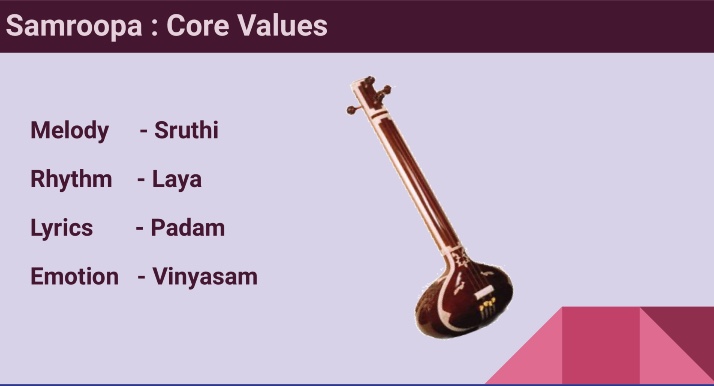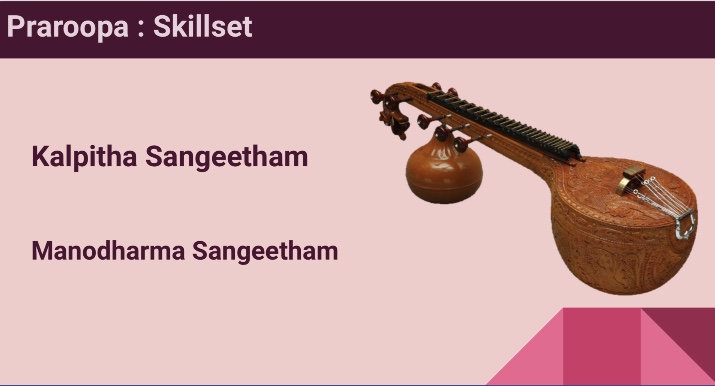Contribute
| “Swaroopa:†Finding The Music Within Oneself |
Sreshtaa Rajesh
07/30/2020
“Swaroopa:†Finding the Music Within Oneself ( Session 5 of the series of lecdem - SampradAyEna Samudhbhavam) In the fifth installation of the series Sampradayena Samudbhavam, we have “Swaroopa,†literally translating to “true nature.†This session was presented by Smt. Aparna Balaji, founder of the Abhyaas School of Music. Due to the pandemic, the lecture-demonstration took place over a live-broadcasted virtual platform, where Smt. Aparna involved a number of her students in an open conversation about the intricacies of Carnatic Music, supplemented with relevant vocal presentations that were enjoyed by all. Within its true nature, Carnatic music seamlessly melds freedom of exploration with structure and form, a beautiful aspect of this artform that was highlighted throughout this session. As such, the focus was on exploring the various aspects of Carnatic music, from the styles of compositions, to the integral components of improvisation (known as manodharma), to the arrangement of a traditional Carnatic concert. The lecture-demonstration opened with “Nada Tanumanisham,†a Tyagaraja krithi in ragam Chittaranjani in praise of Lord Shiva. nAda tanumanisham shankaram namAmi me manasA shirasA I surrender my mind and head to Shankara, the embodiment of “nAda,†the divine sound. This beautiful song reaches out to the Lord, who is said to represent the true form of music--once again connecting to the overarching theme of the day, “swaroopa.†Further on in the krithi, Tyagaraja speaks about how the very scale that is the basis of Carnatic music (Sa, Ri, Ga, Ma, Pa, Da, Ni) originates from Him, the divine. The true form of music is none other than the Lord, thus by being a diligent student of Carnatic music, we are able to better discern our own spiritual nature, as well as connect to that of the world around us. Following this impactful opening, Smt. Aparna spoke about kalpita sangeetam, which are pre-composed Carnatic compositions. The form a composition takes is a strong indicator of its meaning, its scope for musical elaboration, and its place in a larger context (such as a concert), so it is imperative for students of Carnatic music to understand and build a repertoire of different pieces. The segment began with a Geetam in Malahari. Geetams are the first lyrical pieces a student of Carnatic music learns. They have simple rhythmic patterns and are often set to ragas that are more easily grasped by beginners (who, up until this point, have only completed their basic lessons in ragam Mayamalavagowla). The second type of composition that was touched upon was varnams. Varnam, literally meaning “color,†is a pillar of this artform, and Smt. Aparna emphasized its importance to musicians of all levels. Varnams feature lyrical segments interspersed with swaras, and are meant to be practiced in 2-3 speeds to improve one’s ability to deliver quick nuances while still retaining the melody of the ragam. Members of the webinar were treated to a gorgeous varnam in ragam Charukesi. This varnam, composed by the musical maestro Sri Lalgudi Jayaraman, relays the pleas of a nayika who is consumed with thoughts of Lord Krishna and woefully asks Him why He continues to ignore her and play games with her. The lecture-demonstration then progressed to the depiction of more sophisticated compositions. Songs that fall into this category were likely, as explained by Smt. Aparna, to be the “main†piece of a concert. Characteristics of a typical “main piece†are a ragam that allows for a wide range of improvisation, as well as a slower talam. Two such pieces were sung: Nagumomu (a Tyagaraja krithi in Abheri), and Shankari Ninne (composed by Mysore Vasudevacharya in Pantuvarali). Much like a traditional concert layout (covered later in the session), the compositions following the heavy main pieces were light and lively. The audience then listened to a student presentation of Hari Narayana, a sweet, bhakti-filled Purandaradasa krithi in ragam Kedaram. Another student performed a beautiful rendition of Swagatham Krishna, a joyous song in Mohanam exalting Lord Krishna in all his facets. Smt. Aparna then closed kalpita sangeetam with a thillana in ragam Hindolam , a composition of Shri Poochi SrinivasaIyengar. Following this segment was a demonstration by Smt. Aparna and her senior students on manodharma sangeetam--the improvisational aspect of Carnatic music. Manodharma manifests in many forms, but at its core requires a deep comprehension of raga (melody), bhava (emotion), and tala (rhythm). Manodharma, similar to other forms of improvisation, is the spontaneous generation of music with no prior rehearsal or memorization, thus demanding a higher level of proficiency from its students and performers. The first form of manodharma was alapana, which is consequently the most abstract form of improvisation. Alapana does not have a rhythmic meter and it relies solely on the unbounded elaboration of a ragam in all three octaves (lower, middle, and upper registers). As an example, Smt. Aparna sang a brief, yet lilting, alapana in ragam Kalyani. Following alapana, we transitioned to kalpana swaram, the spontaneous presentation of musical notes that conform to a song’s ragam. Kalpana swaram incorporates rhythmic constraints, as each round of swaras ends by connecting back to a line of a song. Swaram is traditionally done at two speeds and culminates in a korvai, which is a mathematical pattern of swaras that properly concludes this type of manodharma. This lec-dem featured kalpana swaram for Manasa Etulo, a composition in ragam Malayamarutam composed by Saint Tyagaraja. The same song was taken as an example for nereval, a form of manodharma that revolves around the variation and creative expansion of a lyrical phrase (often a line from a piece). After thoroughly explaining and displaying the three main forms of manodharma, senior students of Abhyaas spoke about the crown jewel of manodharma sangeetam: the Ragam Tanam Pallavi. This piece traditionally follows the main item of a Carnatic concert and is an entirely original expansion and illustration of a ragam through every previously mentioned form of manodharma in addition to tanam and pallavi. Tanam takes elements from alapana but informally establishes a meter that is defined and maintained in the form of rhythmic syllables: “aa, nam, taa†(hence the name “tanamâ€) during phrases of exposition. Tanam is typically done in two speeds, much like kalpana swaram, and it also has distinct endings that serve as transitions between its respective phases. All of these elements were gracefully displayed by a brief demo of a tanam in Arabhi. Pallavi, the last third of an RTP, is the complete melodic and rhythmic elaboration of a lyrical phrase. Musicians do a full set of nereval and kalpana swaram as is done in many traditional compositions, but the distinguishing factor of pallavi lies in the rhythmic expansion. Here, the pallavi is repeated in four speeds: slow (kizhkalam), normal (madyamakalam), in three counts per beat (thisram), and fast (melkalam). Upon completing melkalam, the singer displays combinations of these speeds in a showcase of their command over the mathematical intricacies of rhythm. We were treated to an impressive rendition of a pallavi in Arabhi in all four speeds. Concluding the segment of manodharma sangeetam was viruttam. Viruttam is the musical rendition of slokas preceding a composition. The viruttam itself repeats lines of the sloka without a meter, allowing for the maximum level of creativity and personal expression from the performer. Viruttams are commonly done in ragamalika, weaving through a series of different bhavas and ultimately converging to the raga of the song. A senior student of Abhyaas masterfully demonstrated this through a ragamalika rendition of “Vasudevasutam devam†in ragas Sindubhairavi and Hamsadhwani followed by a harmonious transition to Gayati Vanamali in Hamsadhwani. In its entirety, manodharma sangeetam was a captivating topic that beautifully displayed the lifelong artistic and spiritual journey that is Carnatic music--there is always more to learn and to explore. By investing time and practice into manodharma, we are enabling ourselves to create and to contribute back to this artform. Finally, Smt. Aparna explained the layout (we can consider this the “swaroopaâ€) of a traditional Carnatic concert format, which was structured by Ariyakudi Shri. Ramanuja Iyengar (1890-1967). Concerts begin with a varnam as a warm-up and a Ganesha stuti as an offering to the Lord to ask that He bless us with a successful performance. The next significant piece is a “sub-main.†The presentation of this item features one or more types of manodharma, setting it apart as a longer, more notable piece in the concert repertoire. Succeeding the sub-main is a fast-paced filler piece which then leads to the main. This heavy piece includes a long alapana, nereval, and kalpana swaram, and is a comprehensive display of a song’s breadth and a musician’s stamina. Following a quick filler comes the RTP, which as described above, is the complete display of a ragam in all its melodic and rhythmic capacity. The compositions that come after the RTP are lighter and are performed without manodharma (excluding viruttam, which often prefaces one of these pieces). These songs effectively wind down the concert as they provide a stark contrast to the longer, more embellished pieces from earlier on in the repertoire. The concert culminates on a strong note with a thillana--a fast-paced, scintillating composition consisting almost entirely of rhythmic syllables. Upon completing this last topic, Smt. Aparna concluded the session with a summary of everything covered in the latest installation of Sampradaya Samudbhavam. Revisiting the title of the session, “Swaroopa,†I would like to highlight Smt. Aparna staying so true to the overarching topic of “true form.†Right off the bat, through Nada Tanumanisham we saw that music is but another manifestation of the Divine. We then delved into the individual nature of compositions in kalpita sangeetam. Subsequently, we were exposed to the various forms that our own creation of music can take when embarking on the journey of manodharma sangeetam. And ultimately, we were shown how all of these singular aspects of music amalgamate into a cohesive form that is an offering to the Lord, to the audience, and to oneself. True to her style as a teacher, Smt. Aparna highlighted the importance of uniting the theoretical, practical, and spiritual aspects of music. Her mission to make the yoga of music accessible is a constant motivation in her teaching, and it is quite remarkable that through her, this lecture-demonstration series is able to serve as a platform for propagating the conversation about this exquisite artform.
You may also access this article through our web-site http://www.lokvani.com/

